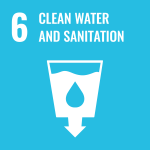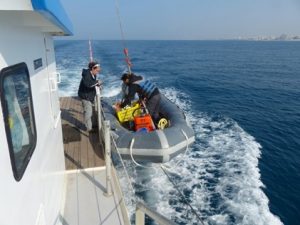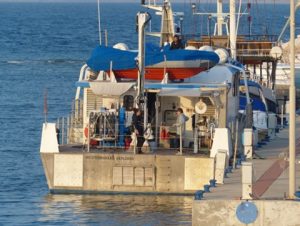 Goal 6: Clean Water and Sanitation
Goal 6: Clean Water and Sanitation
ENSURE AVAILABILITY AND SUSTAINABLE MANAGEMENT OF WATER AND SANITATION FOR ALL
Research
Israel relies heavily on large- scale seawater desalination facilities that supply over 70% of the country’s drinking water. Supplying quality seawater to the desalination plants is essential and requires continual research and monitoring to ensure that varying sources of pollution do not impact the chemical and biological characteristics of the water. Prof. Ilana Berman-Frank, head of the Leon H. Charney School of Marine Sciences, suggests that oil and gas pollution may in fact present a more extensive threat to our desalination plants and drinking water than previously thought, and recommends that the government consider national prevention and management plans.
Research at the Leon H. Charney School of Marine Sciences monitors and targets nutrients in our “blue desert” system that can cause harmful algal blooms that block filters and cause plant shutdown. There are similar concerns pertaining to the expansive jellyfish falls often experienced in the summer months.
Public Engagement
Prof Tamar Lotan, Prof. Dror Angel and Dr. Dor Edelist of the Leon H. Charney School of Marine Sciences and the Leon Recanati Institute for Maritime Studies, from the Faculty of Natural Sciences, educate the public about the potential benefits of jellyfish: “Their mucus can trap microplastic particles to clean up the oceans, and their body contains collagen that cosmetics companies are already applying in anti-aging products.”
In January 2020, an open workshop titled, The Impacts of Seawater Desalination Discharges on the Marine Environment, focused on how the desalination process produces large amounts of brine and other chemicals that eventually enter the marine environment. Professionals from the desalination industry, NGOs, government regulators, and academics were all in attendance. The workshop emphasized the importance of continuous and local monitoring of physical, chemical, and biological parameters near desalination plants to ensure both water quality and ecological viability.
Learning & Students
As technologies advance and population pressures increase, ensuring the availability of water extends beyond the traditional potable water sources. In addition to freshwater, seawater, treated water, and brackish waters can all be treated for utilization. Our students at the Leon H. Charney School of Marine Sciences gain perspective on the different aquatic systems, their potential as potable water sources and their management.
Noy Kadosh from the Department of Natural Resources and Environmental Management presented his thesis, Detecting Cyber-Physical Attacks in Water Distribution Systems: One-Class Classifier Approach, at the 2019 Israeli Water Association Conference. The results of this study demonstrate that one- class classification algorithms can be suitable for the cyber- attack detection problem and can compete with existing approaches. More specifically, this study examines the support vector data description (SVDD) method together with a tailored features selection methodology, which is based on the physical understanding of the WDS topology.

Operations
The water on campus comes from the Mey Carmel company. Beyond the standard testing they do, we contract the Institute for Food Microbiology to regularly test the turbidity, free chlorine, pH, temperature, and Legionella count in nine locations on campus.
Backflow prevention systems are in place on campus allowing water from the city’s public water supply to flow into the University’s piping and stopping water if and when it ever tries to flow backwards into the main water supply. Our backflow prevention system is checked regularly to ensure that our clean water and wastewater are not cross-connected.

